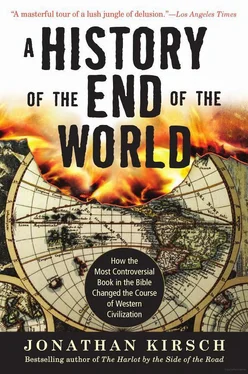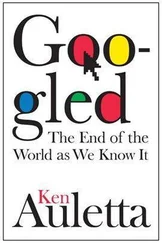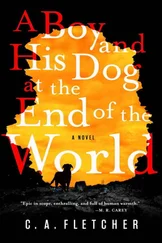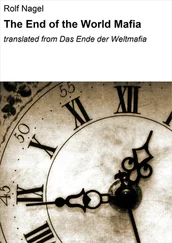The same dreamy conflation of biblical prophesy and baffling reality can be found in The Fifteen Signs of Doomsday, a checklist of the signs and wonders—earthquakes, eruptions, falling stars, and various other oddities and curiosities—that would supposedly signal the arrival of the end-times. The text, which was traditionally ascribed to Jerome but first appeared in Ireland in the tenth century, survives in more than 120 manuscripts and a number of languages. And it suggests that any natural phenomenon—but especially a freak of nature—was likely to provoke a new apocalyptic thrill among those who waited and watched for the end of the world.
If a cow or a donkey gave birth to an offspring with catastrophic birth defects, for example, the medieval reader of Revelation might see apocalyptic meanings in the appearance of the misshapen creature. The so-called “Monk-Calf” and “Papal Ass” were famously touted as miraculous signs of “the abominations of the Roman Church and the nearness of the judgment.” 60And the sighting of the celestial light show that later came to be called Halley’s Comet was understood as a fulfillment of John’s visions in Revelation: “And the fifth angel sounded, and I saw a star fall from heaven unto earth,” writes John, “and to him was given the key of the bottomless pit.” 61
Apocalyptic fancies, no matter how weird or woozy, were capable of taking on the quality of revealed truth. The so-called Tripoli Prophecy, also known as the Cedars of Lebanon Prophecy, first appears in English chronicles of the early thirteenth century as a reading of astrological signs. To the modern reader, the words of the prophecy are near-gibberish:
The lofty cedar of Lebanon will be cut down. Mars will prevail over Saturn and Jupiter, and Saturn will lie in wait for Jupiter in all things. There will be one God, that is, one bishop. The second God will depart. The sons of Israel will be freed from captivity within eleven years. A wandering people considered to be without a leader will come. Woe to the clergy—a new order will grow strong! Woe to the Church—should it fail! There will be changes of belief, of laws, of kingdoms. 62
But the credulous readers of the Middle Ages came to see the Tripoli Prophecy as an eerily accurate vision of the Mongol armies that crossed into Russia from the Steppes of Central Asia in 1237—and as a fulfillment of biblical prophecies of the end-times: “And the sixth angel poured out his vial upon the great river Euphrates,” goes the text of Revelation, “and the water thereof was dried up, that the way of the kings of the east might be prepared.” 63
The sure and urgent expectation of the end-times was, quite literally, a fact of life in the Middle Ages. That is why the author of Mirror of History, an encyclopedia published in 1250, presented the nightmarish visions of Hildegard of Bingen—who came to be called “the German Sibyl” 64—as “future history” rather than mere mystical speculation. Among the book’s other entries were a biography of the Antichrist, a checklist of the signs of the end-times, and a description of the last judgment. 65Neither Christ nor the Antichrist actually showed up, of course, but the long narrative title of a work by a German visionary named Nicholas Raimarus, first published in Nuremberg in 1606, is plain evidence that the end of the world was always regarded as inevitable and imminent: Chronological, Certain, and Irrefutable Proof, from the Holy Scripture and Fathers, That the World Will Perish and the Last Day Will Come Within 77 Years . 66
No incident of life, in fact, was too mundane or too intimate to put someone in mind of the book of Revelation and its promise that the end of the world is near. “Concern with the last things was not limited to fanatics or heretics,” explains Richard K. Emmerson, “but was an essential part of what it meant to be in living in novissimis diebus ”—that is, in the last days. 67
After William the Conqueror put himself on the throne of England in 1066, for example, he famously ordered a survey of his new realm. The result was a book of lists—landowners and land holdings, freemen and slaves and livestock—that is most accurately described as a census tract. The common folk of England, however, were reminded of one of John’s haunting visions of judgment day in the book of Revelation: “And I saw the dead, small and great, standing before God; and the books were opened,” writes John, “and the dead were judged out of those things which were written in the books, according to their works.” 68The royal census “could hardly be further removed from the apocalyptic cataclysms of Judgment Day,” observes Penn Szittya, a specialist in medieval literature, but William’s new subjects spontaneously dubbed it the Domesday Boke (that is, “Doomsday Book”) in “an unspoken analogy” to those fateful books. 69
Even a scandalous love affair might be seen to reveal apocalyptic meanings. When Peter Abelard, a charismatic teacher of theology, seduced, impregnated, and secretly married his young student, Héloïse, the star-crossed lovers were condemned by her uncle, a high churchman in the cathedral of Paris. The outraged uncle contrived to punish Peter with castration, and, as if that were not enough, he kept the lovers apart by confining Héloïse in a convent and sending Abelard into a monastery. The letters exchanged by Abelard and Héloïse are famous, of course. Rather less celebrated is a letter written by one of their contemporaries, who saw the defiant Abelard as the forerunner of Satan: “Peter Abelard already goes before the face of Antichrist to prepare his ways.” 70
Apocalyptic imagery was so pervasive and so powerful that the fingerprints of the author of Revelation, however faint, can be found on the arts and letters of western Europe throughout the Middle Ages, the Renaissance, and beyond, ranging from Caedmon and the Venerable Bede in the seventh and eighth centuries to Petrarch and Chaucer in the fourteenth century and Donne and Milton in the seventeenth century. The villainous Mordred of the Arthurian legend, for example, was seen as a stand-in for the Antichrist, and Merlin the Magician was credited with apocalyptic foresight: “Woe to the red dragon,” Merlin is made to say in a work dating to the twelfth century, “for his destruction is nigh.” 71Even Shakespeare, who preferred to draw his plot lines from classical pagan sources rather than the Bible, conjures up a vision of the end-times that was very much on the minds of his audience in the waning years of the sixteenth century.
O let the vile world end,
And the promised flames of the last day
Knit earth and heaven together. 72
Indeed, the Apocalypse shows up in some altogether unlikely and unexpected places. The medieval manuscript known as the Carmina Burana, a collection of ribald songs and satires and religious poetry dating back to the thirteenth century, includes a ritual of exorcism that invokes a “twisted venomed snake” with a sweeping tail 73—an oblique reference to the “great red dragon” of Revelation whose “tail swept down a third of the stars of heaven, and cast them to earth.” 74And Jan Vermeer, who depicts the mundane scene of a Dutch matron at work with a jeweler’s balance in A Lady Weighing Pearls (ca. 1660), pointedly includes a painting of the Last Judgment on the wall behind her—a wink and a nod to readers of Revelation who know that one of the Four Horsemen of the Apocalypse carries a pair of balances as a symbol of the day of judgment that awaits all men and women in the end-times.
Perhaps the single best example of how Revelation was recycled for various artistic, political, and theological purposes is The Divine Comedy. Dante (ca. 1265–1321) was inspired by not only the canonical book of Revelation but also by some of the more obscure apocalyptic writings of the Pseudepigrapha, including the so-called Apocalypse of Paul, where the apostle is taken on a tour of heaven and hell that resembles the one depicted in Dante’s masterpiece. Dante borrows and uses the familiar imagery of Revelation, including the Great Whore, the woman clothed with the sun, the four living creatures, the seven-headed dragon, the seven lamps, and the twenty-four elders. And he engages in the same kind of apocalyptic projection that can be found in Revelation itself, suggesting obliquely that King Philip of France is the Antichrist and the papal court at Avignon—a rival papacy known in church history as “the Babylonian Captivity” 75—is the Mother of Harlots.
Читать дальше










